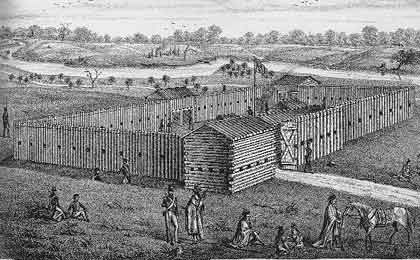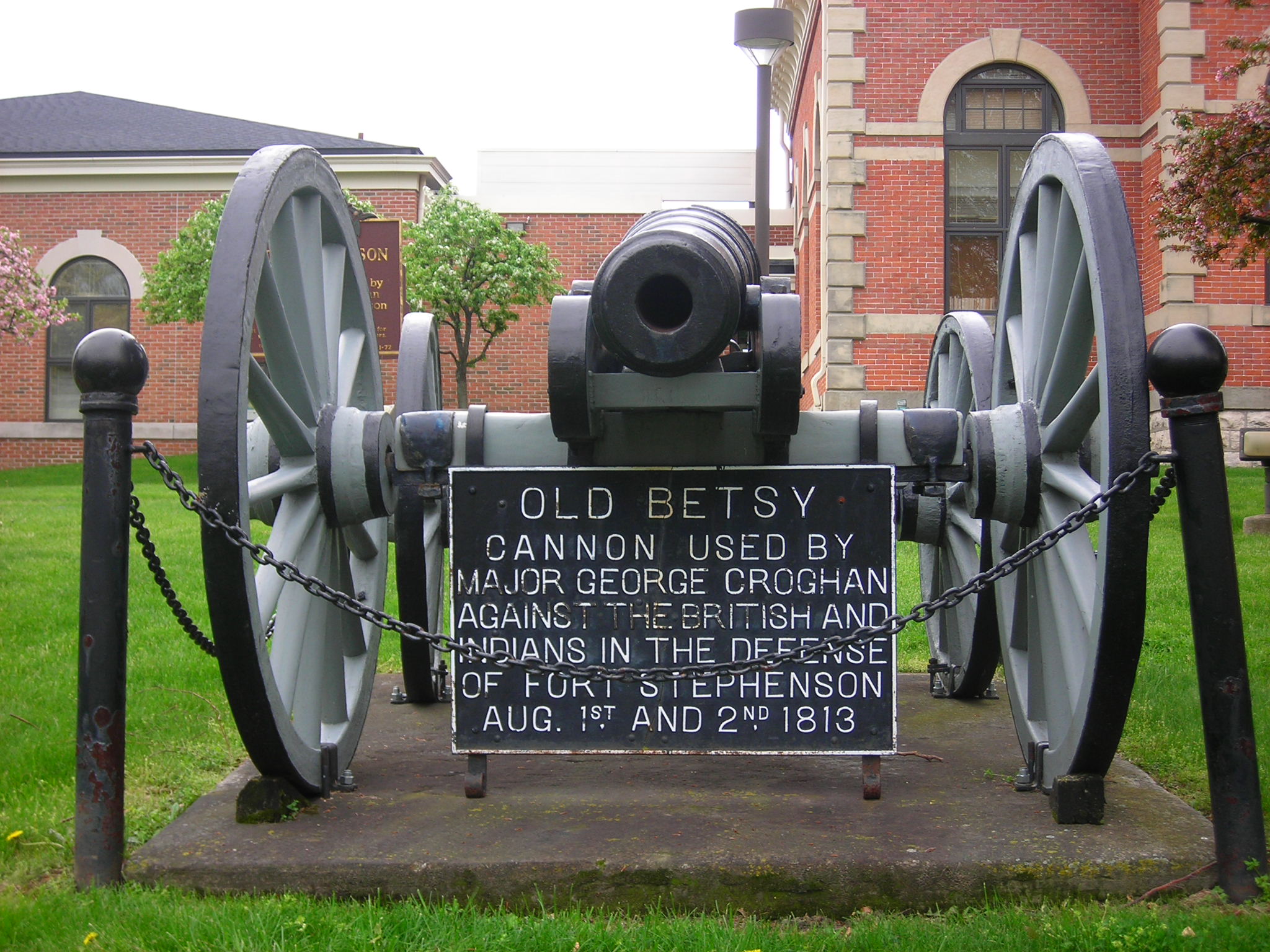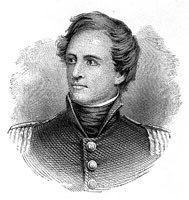Battle of Fort Stephenson
Battle of Fort Stephenson
The United States was only 36 years old as a country when it declared war once again on Great Britain. Americans were angry that the British Navy was taking U. S. ships sailing on the Atlantic Ocean. British sailors were taking U. S. cargo and forcing some U. S. sailors back into the British Navy. If they refused, they were put in British prisons. Americans were angry with Great Britain. But there were problems on the American frontier as well. Back then, the frontier included such states as Ohio, Indiana, and Illinois. The Americans accused the British of supplying natives with arms and ammunition to raid and push American settlers back East. These lands were the natives’ homeland. The raids terrified the people who were settling in these new “western” states. In 1812, President Madison asked Congress to declare war on Great Britain and although the war lasted several years, it was called The War of 1812. A great deal of the war was fought here in Ohio and along Lake Erie. The British could send their soldiers and supplies from Canada through a system of rivers and lakes. The Americans built many forts along rivers, especially those that flowed into Lake Erie. Rivers were the “highways” of the frontier in 1812.
cc: Sandusky County Scrapbook | |
People and Places George William Henry Harrison was a commanding officer in the U. S. Army. In the summer of 1813, he would be commanding from the forts in Northwest Ohio. He would become the 9th President of the United States in 1841. General Henry Proctor the commanding officer of His Majesty’s Forces (British) in Western Canada. General Proctor and the Indian chief, Tecumseh, were allies. Together they wanted to defeat the American troops. Tecumseh, a powerful Shawnee chief, united many tribes to create a large fighting force against the Americans. Fort Meigs was built on the south side of the Maumee River near present-day Maumee and Perrysburg, Ohio. General Proctor’s soldiers and Tecumseh’s warriors tried to trick the American soldiers into fighting outside of the strongly-built fort. The British fired cannonballs over the river and into the fort, but the soft ground and American- built trenches kept the cannonballs from exploding on the soldiers. By the end of July 1813, the British gave-up and moved back eastward. Fort Stephenson was a small rectangular-shaped supply fort built (300 ft. by 150 ft.) on a hill overlooking the Sandusky River. It was named for the first commander who had recently supervised its construction. In those days, the area was called Lower Sandusky named after the river. Very few people lived there except for the Whitaker family, who built a trading post and traded goods with the Native Americans in the area. The fort’s new commanding officer was Major George Croghan. He had just 160 men at the fort and one old cannon from 18th-century French naval wars called “Old Betsy.” Major George Croghan came from a well-known family of courageous men. His uncle was the Revolutionary War general and hero George Rogers Clark. George Croghan was born in Kentucky in 1791, a year before Kentucky became a state. He graduated from The College of William and Mary in Virginia and in 1811 enlisted as a private with the Kentucky volunteers. George Croghan showed so much courage in the Battle of Tippecanoe that he was appointed a captain in the 17th U. S. Infantry. As a result of his bravery during the siege of Fort Meigs, General Harrison promoted him to major and assigned him to the garrison at Fort Stephenson. Only 21 years old, Major Croghan will have to make a very important decision when he receives an order from General Harrison. He will prove that he is courageous, intelligent, and resourceful!
| |
The Orders American General Harrison was very happy that the British had moved away from Fort Meigs, but he also knew that the Native American leader Tecumseh wanted a fight. He thought the next battle might be aimed at Fort Stephenson in Lower Sandusky. General Harrison was afraid that if the British brought many pieces of artillery, Fort Stephenson would fall. Therefore, he sent this dispatch (letter) on July 29th to Major Croghan from Fort Seneca (Old Fort today): “ Sir; Immediately on receiving this letter you will abandon Fort Stephenson, set fire to it, and repair with your command this night to headquarters. Cross the river and come upon the opposite side. If you should deem and find it impracticable to make good your march to this place, take the road to Huron, and pursue it with the utmost circumspection and dispatch.”
| The Reply Unfortunately, the soldiers sent got lost in the woods, and they did not arrive with the message until the next day, July 30th. Major Croghan’s scouts had seen Indians lurking in the woods around the fort and feared ambushes if the men tried to leave. So he sent this reply to General Harrison: “Sir, I have just received yours of yesterday, 10 o’clock P.M. ordering me to destroy this place and make good my retreat, which was received too late to be carried into execution. We have determined to maintain this place, and by heavens, we can.” This dispatch angered General Harrison who did not like his direct orders disobeyed. Another letter was written and delivered (after some difficulty with all the natives in the woods) which relieved Major Croghan of his command over Fort Stephenson. Colonel Wells was sent to command. Major Croghan acted immediately. Taking a squadron of soldiers, he hurried 10 miles south to Fort Seneca to plead his case before the general. Only then did General Harrison believe he was acting out of the best interest and safety of his men to stay and defend the fort. His command was given back, and Major Croghan hurried back to Fort Stephenson to make battle preparation.
|
Battle Preparation Late in July, Major Croghan ordered supply boats (emptied) from Cleveland sunk in the Sandusky River about a half-mile from the fort. Should the British come, the sunken boats would act as an underwater barrier. Soldiers were making cartridges, and rifles were collected for use. The Americans dug a ditch out from the fort’s northwest corner 9 feet wide and 7 feet deep. Heavy logs were attached to the top of the fort’s stockade walls ready to drop as defense measures, and bayonets were nailed to the ramparts to discourage the enemy from scaling the walls. The British used gunboats to move their artillery pieces, and 500 British soldiers within sight of Fort Stephenson. By the afternoon of August 1, 1813, a British howitzer(short cannon) was mounted about a mile below the fort. Early evening British Major Chambers and Colonel Elliott approached the fort carrying a white flag and were greeted by American Ensign Shipp. The British demanded the surrender of the fort! When Ensign Shipp refused, the major said he could not stop the natives from massacring the enemy. Ensign Shipp replied, “….that when and if the fort is taken, there would be none to massacre. It will not be given up while a man is able to resist.” The officers left, and soon the howitzer and guns from the gunboats began firing. Major Croghan returned some fire from the 6-pound cannon, Old Betsy. The soldiers moved the cannon to different corners in the fort, so the enemy would believe the fort had more than one cannon. Then during the night, Old Betsy was moved into the blockhouse on the north wall of the fort where Major Croghan correctly believed the British would advance. The cannon was concealed, and the plan was to open the porthole when the British were close to the fort.
The Battle Early on the morning of August 2nd, the British General Proctor gave the order to begin firing the howitzer and three 6-pounders, which had also been moved during the night to within 250 yards of the fort. The Americans made their last preparations, including moving bags of flour and sand to the fort’s inside northwest corner. All-day, the guns fired at the fort, but the fort held. Over 500 cannonballs struck the fort. Natives remained positioned in various places under cover of the nearby woods. By 4 o’clock, the British marched under cover of the artillery smoke toward the northwest corner of the fort just as Major Croghan thought they would. One smaller column of soldiers approached the fort from the southern angle just as 300 British soldiers marched in double quick time until they were within 50 yards of the northwest angle. Realizing the southern column was a decoy, Croghan ordered all his soldiers to stay together at the northwest angle and to fire their rifles at close range upon the British. The British fell back, but their brave leader, Colonel Short, rallied the men, and they continued until they saw a ditch. Thinking it would be good cover, they followed Colonel Short and jumped into it. These men carried axes and hoped to chop their way through the fort walls. This was just what Major Croghan had hoped for. He ordered the blockhouse port-hole opened, and out came the cannon, Old Betsy. Old Betsy let lose a round of deadly grapeshot and powder the entire length of the ditch. The next column of soldiers followed the first. The British soldiers were caught and could do almost nothing to save themselves. A great many soldiers were fired upon along with their officer, Colonel Short. By 4:30 p.m., the British began to fall back to positions by the river. The darkness of night ended the battle except for the struggle of the wounded British soldiers to survive. Some were able to crawl back down the hill to the safety of the shore and gunboats — others who could not move begged for water. The Americans filled buckets of water and lowered them with ropes over the wall of the fort to relieve their thirst. That night the Indians crept in to recover any injured or dead comrades.
| |
The Letters General Proctor ordered a retreat before dawn. Tecumseh, who had been waiting in the woods between Fort Meigs and Fort Stephenson, lost his chance to fight. The British left so hurriedly that a boat with clothing and guns was left behind. The Americans buried the British left dead. Only one American, a 14 year- old boy, had been killed. General Proctor later recorded 23 killed in action (including Colonel Short), 28 wounded and missing, and 35 wounded. Major Croghan sent this note to General Harrison: Dear Sir: The enemy attempted to storm us last evening, but was repulsed, with the loss of at least two hundred killed, wounded, and prisoners. One Lieutenant Colonel Short, a Major, and a Lieutenant, with about forty privates, are dead in our ditch. I have lost but one in killed and but a few wounded. Further statements will be made you by the bearer. | Victory This battle ended the British efforts to take forts in Northwest Ohio. Realizing the Americans could freely use the rivers to resupply their soldiers, the British retreated to Canada. President Madison was so pleased that he honored Major Croghan by promoting him to Lieutenant Colonel. Congress awarded him a gold medal and the ladies of the Ohio capital, Chillicothe, awarded him a beautiful sword. Young Lieutenant Colonel Croghan was a national hero. |



